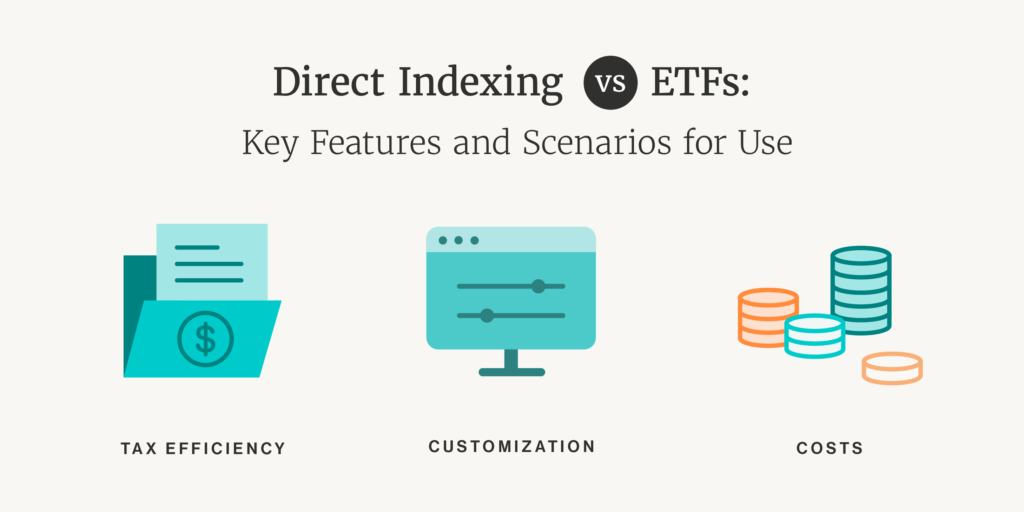
Direct indexing is an investment strategy that involves purchasing and holding individual stocks (or other securities) that make up a specific market index, such as the S&P 500, to replicate its performance. Unlike traditional index funds or exchange-traded funds (ETFs), which pool investor money to track an index indirectly, direct indexing gives investors direct ownership of the underlying securities in a separately managed account (SMA). This approach has been around for decades but has gained popularity with advancements in technology that make it more accessible.
These portfolios are often built with trading software programs that utilize trading algorithms for efficiency. Providers often use these algorithms to sample a subset of index holdings, such as 150 stocks from the Russell 1000 to closely mirror returns without full replication of the index, therefore you don’t need to own 1000 securities.
As an example, the algorithm may sell Coca Cola at a loss and buy Pepsi as a replacement to capture a tax loss. While there is no guarantee the two securities will perform the same, the overall makeup of the total grouping of stocks would typically not deviate substantially from the index itself. This allows the program to generate tax losses as they happen.
Some of these programs will review a portfolio monthly or weekly, and some will even trade daily.
The key benefit is greater tax-loss harvesting, where underperforming stocks are sold to offset capital gains taxes at a time when the overall market index may be positive. However, it typically comes with higher management fees (often 0.30%–0.40% annually) compared to buying a low-cost S&P 500 ETF at closer to 0.03%.
When Is Direct Indexing Worth It Compared to Buying ETFs?
ETFs are simpler, more liquid, and less expensive for most investors, making them ideal for broad market exposure with less complexity. Direct indexing can make sense in taxable accounts where tax management can add meaningful after-tax returns, but its value depends on your portfolio size, tax situation, and goals. For smaller or tax-advantaged accounts (like IRAs), the added complexity and fees generally don’t justify switching from ETFs.
Direct indexing may be worth it for portfolios of high-net-worth individuals in higher tax brackets who need to maximize tax-loss harvesting and customization.
An example might be someone who already has a concentrated position in a specific company due to stock options or a company stock purchase plan. Nvidia currently makes up about 7.5% of the S&P 500. If an investor already had a large concentration in Nvidia that had a substantial gain preventing them from selling it, they may not want to add to it. By simply buying the S&P 500, they would be adding to their Nvidia exposure. In such a case, if the portfolio was sizeable enough, they may want to explore direct indexing to avoid further stock concentration by replicating the index without Nvidia.
Typically, you want the allocation to the area of the market that will be utilizing direct indexing to be sizeable enough to justify the added cost in comparison to the tax alpha being generated. We would argue that it is probably at least a $1 million allocation. At this level, the potential after-tax alpha (outperformance) from tax strategies can possibly outweigh the higher fees. Studies suggest 1%–2% annual tax savings in volatile markets. Below $1 million, the benefits are often marginal due to the costs. A number of firms set minimum investment requirements well below that level, often as low as $100,000. However, the justification is questionable at lower asset levels.
Keep in mind that a well-diversified portfolio has exposure to many asset classes. As a result, when we say a $1 million minimum to replicate an index, that means $1 million for just that portion of your portfolio. As an example, if an investor has a portfolio balanced between 60% stocks and 40% bonds, only a portion of that 60% would be invested in large cap companies benchmarked against the S&P 500. Perhaps that might be 35% of your total allocation. Which means you would need at least $3 million in total non-retirement investments to justify the allocation to a direct indexed portfolio.
In addition, due to the high trading activity of the direct indexing algorithms, there tends to be much more paperwork generated at tax time on your 1099-div issued by your broker-dealer, which can be an annoyance for you and your tax advisor. As a result, you want to ensure the strategy makes sense for you.
It’s also important to note that investors that are utilizing ETFs, or advisors that are utilizing them on behalf of their clients can still tax-loss harvest positions from one market index to the other (such as the S&P 500 into the Russell 1000) when the opportunity presents itself and still do so at a lower cost. This is a very common tax-loss harvesting approach that can also generate tax alpha over time.
While there is a place for direct indexing to combat certain circumstances, in most cases ETFs are still a more practical solution for the typical individual client. Always remember that each client’s circumstance is unique, and all options should be considered.
About the Author
Joseph M. Favorito, CFP® is a Certified Financial Planner® as well as the founder and managing partner at Landmark Wealth Management, LLC, a fee-only SEC registered investment advisory firm. He specializes in helping individuals and families develop comprehensive financial strategies to achieve their long-term goals.
